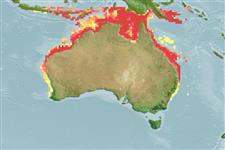>
Scombriformes (Mackerels) >
Scombridae (Mackerels, tunas, bonitos) > Scombrinae
Etymology: Scomberomorus: Latin, scomber = mackerel + Greek, moros = silly, stupid (Ref. 45335).
Environment: milieu / climate zone / depth range / distribution range
Ecologia
marinhas; estuarina; oceanódromo (Ref. 51243); intervalo de profundidade 1 - 100 m (Ref. 6390), usually ? - 30 m (Ref. 6390). Tropical; 7°S - 35°S, 110°E - 157°E (Ref. 168)
Western Pacific: largely confined to inshore coastal waters of southern Papua New Guinea and northern and eastern Australia, from Shark Bay and Onslow, Western Australia to Sydney, New South Wales. This species was confused with Scomberomorus guttatus.
Comprimento de primeira maturação / Tamanho / Peso / Idade
Maturity: Lm ?, range 48 - ? cm
Max length : 100.0 cm FL macho/indeterminado; (Ref. 168); common length : 80.0 cm FL macho/indeterminado; (Ref. 168); peso máx. publicado: 12.2 kg (Ref. 3132)
Espinhos dorsais (total) : 16 - 18; Raios dorsais (total) : 17 - 19; Espinhos anais: 0; Raios anais : 16 - 20; Vértebras: 48 - 49. Interpelvic process small and bifid. Lateral line gradually curving down toward caudal peduncle. Intestine with 2 folds and 3 limbs. Swim bladder absent. Body covered with small scales. Membrane of first dorsal fin jet black with large contrasting areas of intense white between the 6th and the last spine. Sides of adults marked with about three indefinite rows of indistinct bronze-gray blotches (absent in 9.5 cm juveniles).
Schooling species which moves into inshore waters, bays and estuaries of Queensland during the southern midwinter and early spring. Often inhabit very turbid coastal waters shallower than 30 m (Ref. 6390). Common length 50 to 80 cm FL (Ref. 12241). Seasonally migratory in the Gulf of Carpentaria and form mixed schools with S. commerson over shallow reefs offshore of Queensland. Trolling lines with lures such as metal spoons and cut bait are used by recreational and commercial fishermen. Mostly marketed fresh (Ref. 9987).
Ciclo de vida ou comportamento de acasalamento
Maturities | Reprodução | Spawnings | Egg(s) | Fecundities | Larvas
Collette, B.B. and C.E. Nauen, 1983. FAO Species Catalogue. Vol. 2. Scombrids of the world. An annotated and illustrated catalogue of tunas, mackerels, bonitos and related species known to date. Rome: FAO. FAO Fish. Synop. 125(2):137 p. (Ref. 168)
Status na Lista Vermelha da UICN (Ref. 130435)
Ameaça para os humanos
Reports of ciguatera poisoning (Ref. 6390)
Uso pelos humanos
Pescarias: espécies comerciais; peixe esportivo: sim
Ferramentas
Relatórios especiais
Baixar XML
Fontes da internet
Estimates based on models
Preferred temperature (Ref.
123201): 24.5 - 28.6, mean 27.4 °C (based on 302 cells).
Índice de diversidade filogenética (Ref.
82804): PD
50 = 0.5000 [Uniqueness, from 0.5 = low to 2.0 = high].
Bayesian length-weight: a=0.00832 (0.00383 - 0.01808), b=3.03 (2.86 - 3.20), in cm total length, based on LWR estimates for this Genus-body shape (Ref.
93245).
Nível Trófico (Ref.
69278): 4.5 ±0.8 se; based on diet studies.
Resiliência (Ref.
120179): médio(a), tempo mínimo de duplicação da população 1,4 - 4,4 anos (tm=1-2).
Fishing Vulnerability (Ref.
59153): Low to moderate vulnerability (33 of 100).
Nutrients (Ref.
124155): Calcium = 38.2 [17.5, 147.4] mg/100g; Iron = 0.94 [0.43, 2.31] mg/100g; Protein = 21 [20, 22] %; Omega3 = 0.295 [0.178, 0.499] g/100g; Selenium = 66.7 [23.7, 308.3] μg/100g; VitaminA = 14.9 [2.9, 71.4] μg/100g; Zinc = 0.756 [0.504, 1.192] mg/100g (wet weight);
